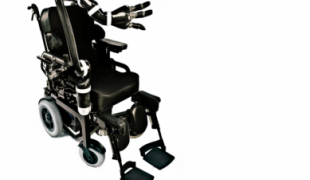- 8833
- 634
- 17
- 14
- 0
- Help Ukraine
About the solution
The PEAC system uses a wireless signal which allows its users to perform house tasks such as opening and closing doors, calling an elevator, and operating the TV and lights. They carry out these tasks with small movements of their eyes - or, for some patients, using brain waves.
When Steve was diagnosed, in 2006, the doctors told that he had three to five years to live. The patient was not willing to accept this, so he began researching his options to determine the best approach to surviving his incurable condition.
"From the beginning, I was determined to live another 38 years," the architect explained.
As he began his research for solutions, after realizing he couldn’t find a cure, but could figure out how to improve his quality of life despite of his disease, he met other ALS patients. Steve realized that many of these patients had 24-hour home care or were confined to beds in nursing homes, soiling their own sheets, with extremely limited person-to-person contact.
"Our society treats prisoners with more dignity and respect than the chronically disabled, kept alive but with no life. I knew that I had to work quickly to avoid their fate", the inventor said.
Steve met Barry Berman, the CEO of the Chelsea Jewish Foundation, an assisted-living facility in Massachusetts. Berman was developing a new kind of nursing home that he called a GreenHouse, specializing in the care of young people with disabilities, particularly ALS and multiple sclerosis.
With a grant of $500,000 from Berman, the architect started designing an electronic automation system – PEAC - with the goal of creating a nursing residence that would feel like home, empowering the patients by making them more independent. The system allows patients with ALS to control their environment in the assisted living center movements such as blinks and facial twitches. They can open and close doors, turn on and off lights, change TV channels, and control heat and air-conditioning, among other things.
The Steve Saling ALS Residence opened in Chelsea in February 2010, the first long-term care facility designed for people with this disease. The patients can navigate around the residence by themselves and have visitors.
"Don't make the mistake that all of my doctors did and assume that because I am 100% dependent on the care of others for the rest of my life, that I don't have a quality of life. I can't imagine enjoying life more”, Steve observed.
Adapted from: http://cnn.it/2nEJVAD
这些解决方案不应包括使用药物,化学品或生物制品(包括食品);创伤性设备;冒犯性的,商业或内在危险的内容。该解决方案未经医学验证。请谨慎进行!如果您有任何疑问,请咨询健康专家。
DISCLAIMER: This story was written by someone who is not the author of the solution, therefore please be advised that, although it was written with the utmost respect for the innovation and the innovator, there can be some incorrect statements. If you find any errors please contact the patient Innovation team via info@patient-innovation.com
-
-
301
-
0
-
3407

Ronaldo Cohin, father of a child with autism and a Computer Science student, created the Jade Autism app.
COMMUNICATION: Communicating, whether by speaking, listening, or other means
Autism
App (Including when connected with wearable)
Enhancing health literacy
Promoting self-management
Managing Neurological Disorders
Building Supportive Community Relationships
Promoting inclusivity and social integration
Enhancing Mental Health
Improving Speech and Communication
To improve Treatment/Therapy
General and Family Medicine
Neurology
Pediatrics
Psychiatry
Brazil
-
-
-
267
-
0
-
2967

Mother Eileen Lamb implemented a series of voice assistant-driven strategies to support her raising her two autistic children.
COMMUNICATION: Communicating, whether by speaking, listening, or other means
CAREGIVING
Social interaction
(SELF)-CARE: GROOMING: Personal grooming, such as combing hair or shaving
Autism
Strategy/Tip
AI algorithm
Promoting self-management
Managing Neurological Disorders
Promoting inclusivity and social integration
Improving Speech and Communication
To improve Treatment/Therapy
Preventing (Vaccination, Protection, Falls, Research/Mapping)
Caregiving Support
Child and Adolescent Psychiatry
General and Family Medicine
Neurology
Pediatrics
United States
-
-
-
363
-
0
-
5875

Jaco – A robotic arm to attach to wheelchairs
(SELF)-CARE: EATING: Eating independently.
(SELF)-CARE: DRINKING: Drinking independently.
MOVING IN A WHEELCHAIR: Moving using a wheelchair.
(SELF)-CARE: GROOMING: Personal grooming, such as combing hair or shaving
(SELF)-CARE: DRESSING: Dressing independently.
COMMUNICATION: Communicating, whether by speaking, listening, or other means
Assistive Technology access
Restoring mobility
Enhancing health literacy
Managing Neurological Disorders
Neurology
Neurosurgery
Physical Medicine and Rehabilitation
Canada
-
 zh
zh